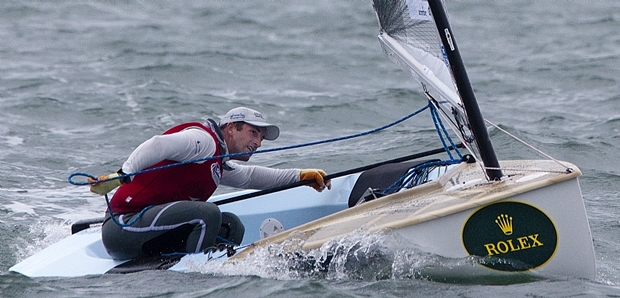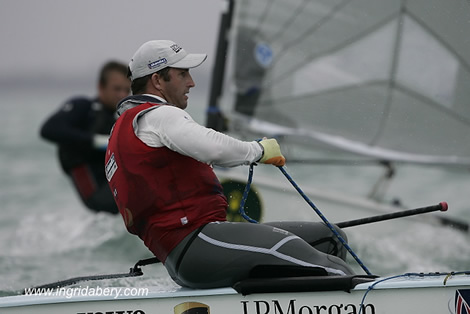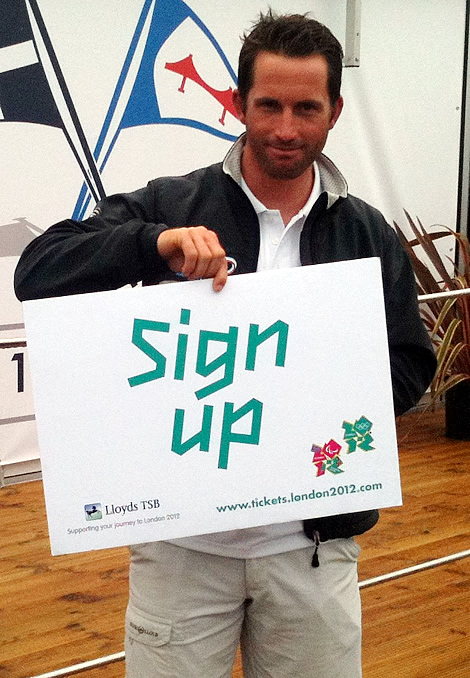
Free pumping in 10 knots
Following the demise of TeamOrigin, Ben Ainslie is now 100% focussed on his Finn campaign for 2012, a place he knows only too well, this being his fifth Olympic campaign. With the tenuous excuse of today marking 18 months to go until sailing gets underway at London 2012, we felt it was appropriate timing to catch up the man who next year has the potential to make himself the greatest ever Olympic sailor...
The end of 2010 was good for Ainslie. As the swansong for TeamOrigin, he and his match racing team won not only the Monsoon Cup, the final event of the 2010 World Match Racing Tour, but in doing so claimed the Tour itself and Match Racing World Championship title. Over December Ainslie was in Australia with his Finn and competed at Sail Melbourne, where the Brits roundly dominated the class. There Ainslie showed he has lost none of his dinghy sailing skill, winning the regatta ahead of 2010 Finn Gold Cup victor Ed Wright and the talented, tall nipper, Giles Scott.
Ainslie this week is competing at Rolex Miami OCR, where not all is going his way. On Biscayne Bay Giles Scott is proving the force to be reckoned with.
“We’ve had a couple of days of good racing in 12-18 knots, long courses and steady breeze, so it has been pretty hard work physically, but it has been really good,” said Ainslie when we spoke to him yesterday. “Giles is sailing really well - he’s certainly really quick in these conditions with flattish water and medium to strong breeze and he’s got good pace on the rest of the fleet. It’s good for him, but for the rest of us it is hard work trying to close the gap.”
According to Ainslie, Scott’s straight bullets at Rolex Miami OCR (apart from his OCS discard from yesterday) are due to him sailing well, but is also down to technique, since the minimum wind speed for the Finn class’ free pumping rule has been dropped from 12 to 10 knots. “That two knot range is quite important especially when it is like here in Miami with flat water - all of a sudden you don’t have any waves to catch and being that little bit lighter, it just turns into a ‘rock and pump fest’ rather than a ‘steering and surfing the waves with a little bit of pumping fest’.”

Ainslie doesn’t sound overly enamoured with this rule amendment as he feels it changes the game, but nonetheless he is getting to grips with it. “I’m not sure it is sailing any more when there aren’t any waves around. It is just a case of the harder you work the faster you go, but that is the way it is these days and you just have to embrace it and learn the techniques and get that specific fitness going. It is incredibly hard work – I’ve never experienced anything like it before, but it is something I am learning. Certainly Giles seems to have the technique licked compared to everyone else.”
On day one Scott was a country mile ahead of the rest of the fleet. On day two it was closer, says Ainslie. “It is good to be out here seeing it and getting closer to it. Obviously it is hard, but it is a good challenge trying to close the gap. It is fantastic to be here and be out there going through it and working on the technique. This downwind free pumping in the flat water when there aren’t any waves to catch - it’s just incredibly physical. Sometimes I feel I could do with being 15 years younger on the runs! The physios are having a hard week!”
Over the winter Ainslie says he has been working hard not only on his fitness, but getting up to fighting weight for the Finn. However he says there is no training, be it fitness or technique, comparable with competing at a regatta particularly with the new skill set and fitness required to master the free pumping.
In terms of how the class has changed since the last Olympic cycle, Ainslie says the bar has been raised and he reckons there is now more depth in the Finn class compared with four or five years ago. In particular he cites his team mates Giles Scott and Ed Wright (not competing in Miami), American Zach Railey, who took home silver from Beijing, and Australian Brendan Casey.
He adds that the amended free pumping rule has also had an effect on the form. “On the downwinds now, apart from one or two people, the fleet is going at a much more similar speed because everyone can pump, whereas before it was about technique and finesse with the waves and the balance of the boat. Now it is just more about brute force. So we’ve seen some people who in the past weren’t necessarily very fast downwind, all of a sudden are now because they are very fit and strong. So it has changed the dimension of the fleet dramatically.”
18 months to go until the Olympic Games is an odd time for Olympic contenders. There are no better examples than in the British Finn squad where there are three candidates all capable of winning gold in Weymouth next year. This year the game is purely about getting selected and the criteria for this seems vague. Obviously it is important to do well at certain regattas – one imagines these will particularly be Skandia Sail For Gold, moved to June this year because of the Olympic Test Event being held in Weymouth over the first two weeks of August and then the ISAF Sailing World Championships in Perth in early December. Good results in these will help, but ultimately the decision will be a subjective one, made by the selectors.
“This year is going to be about peaking at the right events to qualify but that’s nothing new," says Ainslie. " I’ve had plenty of qualification battles over the last four or five cycles I’ve been involved with, but hopefully I can get through and keep improving.”
At present Ainslie has no real idea of how much top results in key events will form part of the selectors' decision, nor of the time frame inwhich they will making that decision. While in classes where there is more or less only one candidate, such as the Star and RS:X classes, selection may occur before the ISAF Worlds. In classes where it is tighter, a decision might not be made until 2012. As Ainslie puts it: “As sailors we are puppets to a certain extent and really we just have to focus on performing as well as possible.”
With his work cut out for him getting up to speed in the Finn, Ainslie hasn’t had much thought about pursusing any other sailing this year. Chums Iain Percy and Andrew Simpson are attempting to get funding to campaign the TeamOrigin TP52 this season but Ainslie says he isn’t part of this plan. “Obviously it is pretty tough times here trying to get my fitness back and catch these young guys up. There is a possibility I might do some other events, but it’ll fit in around the Finn and we’ll see what happens.”
From March there will be the opportunity to buy tickets to watch the Olympic sailing. These go on sale from 15 March this year, available from www.tickets.london2012.com with the price of adult tickets starting at £20.
Applications for Olympic Games tickets will open for six weeks, enabling people to consider their options before making their final choices and submitting their application. Applications will close on 26 April 2011 and all oversubscribed sessions will be allocated via a ballot process. Applications can be made at any point during the six week application period – it is not a first come, first served process.










Latest Comments
Add a comment - Members log in